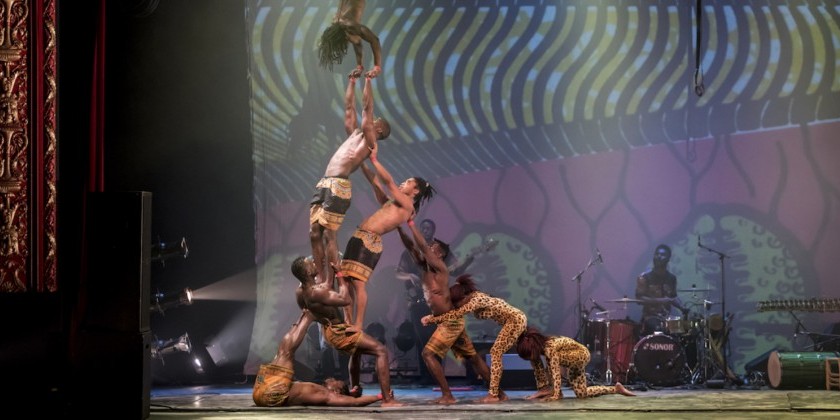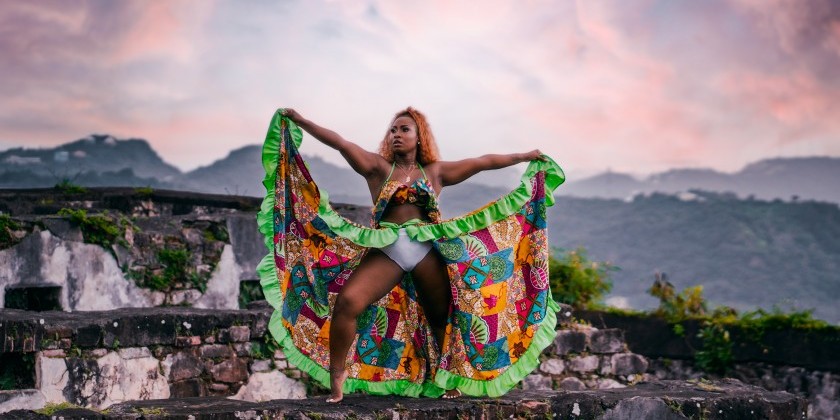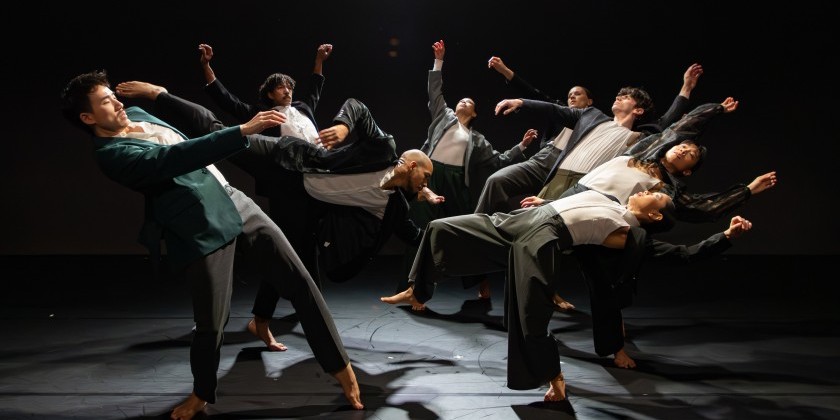IMPRESSIONS: Dance Africa 2025 at Brooklyn Academy of Music — Movement! Magic! Manifestation!

Culture Knows No Borders
Dance Africa is the largest festival annually paying tribute to the legacy and culture of Africa and its diaspora. Founded over 48 years ago by Dr. Baba Chuck Davis, this festival spans the Memorial Day weekend, offering a film series, panel discussion, an international marketplace, movement workshops, and the crown jewel — a performance series featuring an international or national guest company.

Movement! Magic! Manifestation! was this year’s theme, curated by the current artistic director, Abdel R. Salaam, who welcomed The Song and Dance Company of Mozambique, featuring 21 artists that represented the diverse music and movement of their homeland with grace and style.
Others who completed the program included Mama Coumba Saaraba (a young local sabar and djembe dance company led by Fatouseck Primus), the Billie Youth Arts Academy Dance Ensemble (Dance Africa Division directed by Karen Thornton), the Dance Africa Spirit Walkers (a division of Forces of Nature Dance Theatre Company directed by Abdel R. Salaam), and the Candle Bearers (led by Dr. Hanaan Hameem).

MOVEMENT!
My strong background in Western aesthetics, including ballet and traditional modern dance, combined with my experiences in Black Theatre Arts and vernacular movement, has afforded me the ability to analyze the physical and sonic components of African music and dance with profound clarity. The depth of my physical experience with the Forces of Nature Dance Theatre Company is centered in Salaam’s West African dance teachings and choreography, with a focus on the dances of the Jali, keepers of the history of the community. This information has led to the development of my course at both Princeton and Hofstra Universities, “The American Experience and Dances of the African Diaspora,” which examines the evolution of the cultural impact of dances from Africa and its diaspora.

Over the past 10 years, as a Dance Africa Spirit Walker, I’ve had the unique opportunity to witness various cultures and dance languages from South, West, and most recently East Africa. Specific dances are performed during funerals, births, coming-of-age ceremonies, and weddings. This brings me to the familiarity and sense of joy I felt when watching Mama Coumba Saaraba perform Yela/Wango (an excerpt from The Wedding).

Although the dance movement and drumming are not part of my movement/music language base, I still felt a special kinship with the focus of the Senegalese sabar dance. Sabar drums, played with sticks, create a sharp staccato “clack clack clack…” explosive sound, and the dance movement responds even more explosively with high-flying kicks and low-swiveled hips, while fabric is twisted in opposing directions. It is clear that the legacy of her parents, Mama Andara and Baba Obara Wali Rahman, continues through Fatouseck’s vision with this young company.

Dance and its musical accompaniment in many forms of traditional cultural expression are identified by the same name; hence, sabar dance is sabar drumming. "There is no dance without music, there is no music without dance," Chief Ayanda Clarke, founder of the FADARA Group, says. "Music is the sonic representation of movement and movement is the physical interpretation of sound." I agree.

MAGIC!
Ancestral reverence, a foundational credo in Dance Africa and the life walk of many people of African descent, was evident from the moment one entered the theater. Recorded names were uttered, many of whom were founding members of the festival or notable figures who transitioned during the past 48 seasons. Each year, Salaam dedicates a new memorial tribute performed by the Dance Africa Spirit Walkers. This division of Forces of Nature Dance Theatre, along with the alumnae of The Billie Youth Arts Academy Dance Ensemble, presented a unique tribute complete with multimedia and AI that made our audiences gasp.

A film excerpt seamlessly transitioned into a staged ritual, after which mystical, magical AI images of Black women floated above a lagoon with lit candles, blessing the audience. A backdrop of Salaam’s elaborate costume sketches provided additional visual stimulation for an ancestral celebratory dance in wide-legged white pants.
Another AI piece, perhaps the most provocative, featured bare-chested, muscular Black men simply walking through a desert accompanied by elephants adorned in colorful painted patterns. This AI also paid homage to the elephant, the totem animal of Mozambique.

The next spirited and intense dance included the Billie Youth Arts Academy Ensemble in an intergenerational experience; all wore brightly colored African fabrics known as the capulana. This is the fabric and colors of resistance worn during the revolution that freed Mozambique from Portuguese rule exactly 50 years ago. Salaam, his Spirit Walkers, and the Billie Youth Arts Academy Ensemble metaphorically celebrated the story of resistance and revolution.

Through earlier Dance Africa presentations, Rwandan dance/music (2019), Zulu dance/music from South Africa (2018), and Brazilian folkloric dance/music (2015), created foundational threads that became glaringly evident to me in the movement and music of Mozambique over Memorial Day weekend.
The Song and Dance Company of Mozambique’s first offering, Tufu/Ntsope, featured three distinct components that were extremely vibrant. The first component included dancers from the Billie Youth Arts Academy Dance Ensemble, a select group of dancers who are given the opportunity to learn and perform with the guest company in Dance Africa. This serves as evidence of an intentional intergenerational community activity.

Secondly, the movements consisted of relatively simple shoulder isolations while kneeling, with arms positioned delicately in an open, welcoming position with the index finger and thumb lightly pressed together. Was this a mudra from the Indian traditions of Bharatanatyam or Odissi? Did the shoulder movement reveal the influence of the Rwandan Umushayayo (women’s dance) or the Ethiopian Eskista (“dancing shoulders”)?
Oh boy, this is going to be a mind-blowing ride!

The third component was a single rope Jump Rope game. We know there are many Black American girls who cut a MEAN Double Dutch, so I patiently waited for something remarkable to happen, and it did. It’s important to share that the jumpers were accompanied by drummers while improvising rhythmic accents, showcasing each woman’s ability. One even ”jumped” from a seated position, reminiscent of the South African Zulu dancers who drop-plop on their buttocks from a standing position.

As the drummers' speed increased, so did the speed of the rope turners, and the dancers responded with even more intricate footwork. The energy in the entire theater began to rise, and by the time they stopped, I was a believer. Our Double Dutch had found its sister from across the pond.
MANIFESTATION!
Intersectional ties are those “ahas” that prove we are indeed one family. The next piece, Xigubo, has a fascinating legacy. Our translator, musician, and educator, Lindo Cuna, shared that during Shaka Zulu’s war campaign, the Shangaan people of southern Mozambique came to his aid in support of his military efforts by preceding him in battle. It is no surprise, then, that this warrior dance sounds and feels like one of the dances of the Zulu Nation.

A soloist’s exciting entrance through the house drew gasps and audible cheering from the audience. He was adorned in a raffia leggings and a short, white fur skirt, with a headpiece reminiscent of those worn by the South African visiting company in 2018. The dancer, jumping in what appeared to be very challenging “fourth position stags,” carried a spear in one hand and a shield in the other. The accompanying drumming was almost identical to what I recall hearing from the South African Company. Wow, my mind was exploding!

The Mozambique company shared two pieces in celebration of Ancestors. In the first dance, Mapiko, a masked dancer representing an ancestral spirit named Lapiko, who danced only with the women. In villages that actually practice this ritual, Lapiko must be embodied by a member of a secret society. It is important to note that what we witnessed was a theatricalized version of a playful exchange between the villagers and Lapiko.

Later in the program, as the women sang, five men representing ancestral spirits wore costumes that accentuated their movements, with fringed layered fabric covering their faces and most of their torsos. They appeared to communicate with each other in Nyau.

Musical interludes provided dancers with time to change costumes and also gave us the opportunity to marvel at the timbila, a slat and gourd-crafted instrument played with mallets. The Mozambican timbila is the East African version of the West African balafon. Centuries later, the instrument morphed into the Western xylophone. Many African instruments are created as a direct result of Mother Nature’s gifts; small gourds found in East Africa are tied underneath the wooden slats and produce a slight buzzing sound, while larger gourds of the balafon create a deeper resonance. In some instances, 10-20 timbilas, all pitched in a specific tonal arrangement, can comprise an orchestra. Special guest Michael Wimberly, a brilliant percussionist and composer who traveled with Urban Bush Women during their residency with the Mozambique company approximately 15 years ago, was introduced to the wonders of the timbila. This year’s audience was blessed to hear this musical reunion producing some of the most beautiful buzzing tonalities. Is this because beeswax is used to secure the gourds?

Ngalanga was the final work of the evening. It was a playful expression of community, as dancers paired up, speaking through their bodies in celebration of the gift of life itself. Suddenly, I recognized the powerful rumblings of the rhythms of Brazil. Lindo mentions a dance called semba, featuring fast, rhythmic fancy footwork... Hmm, perhaps this is the great ancestor of the dance we’ve come to know and love: the Brazilian samba. Why not? Culture knows no borders.
As our guests prepared for their return, I asked if they would have time to relax. “No way,” they replied. “We have two weeks to create a new work for our 50th Anniversary Celebration of Independence.”
May the ancestors continue to provide the blessing of work and the gift of creativity.









